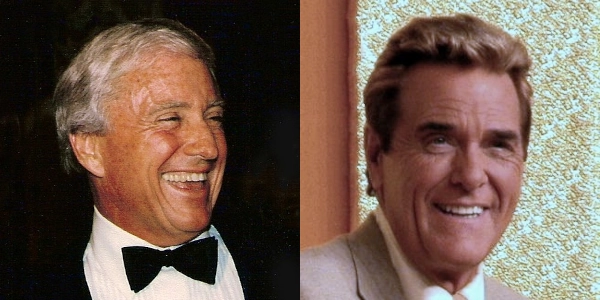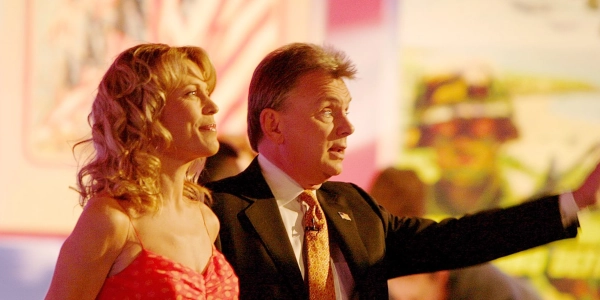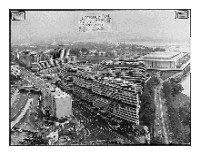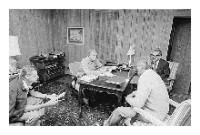Click here to Sponsor the page and how to reserve your ad.
-
Timeline
1975 - Detail
January 6, 1975 - The television show Wheel of Fortune premieres.

It would be the brainchild of Merv Griffin, a radio and Big Band singer of I'm a Lovely Bunch of Coconuts fame (yes, look it up, three million copies sold, Top Ten hit) and many others, an actor, talk show host, and inventor of game shows. Wheel of Fortune would not be his first, starting to host them in 1958 and produce several years later. There will be others you know almost as well. Griffin at first called what would become Wheel of Fortune, Shopper's Bazaar, using a crossover version of Hangman and Roulette as its main premises. That version was not picked up by the network; neither were the second or third pilots. After a bit of tinkering, Wheel of Fortune debuted on January 6, 1975 in the 10:30 a.m. slot for NBC, and nobody thought that it would become the American icon it is today, now hosted by Vanna White and Ryan Seacrest. But the primary forces past Merv were in the decades long tandem of Vanna White and Pat Sajak. But they were not the first hosts; think Chuck Woolery, letter turner Susan Stafford, and what would become the long time announcer, in 1976, Charlie O'Donnell. In the early years, contestants would shop for their prizes and celebrity guests started the tradition of gifting their winnings to charity. Over $5.4 million has been donated to date. At first, the board was analog. It took until 1997 for it to become digital. At first, there was only a daytime version, lasting until 1991; the syndicated night version was added in 1983 with fifty stations and is the version on today.
So when did Pat Sajak replace Chuck Woolery and why? Woolery wanted the same salary as Peter Marshall got as host of Hollywood Squares, $500,000. Griffin stood firm. On December 28, 1981, Sajak became the host for $65,000. A former disc jockey and weatherman, with a quick wit and slight sarcastic tone, Sajak quickly became a favorite of the audience. Although it is said that Pat Sajak did not always love being typecast as the host of a game show, his time on Wheel of Fortune, forty-three years, would bring it unprecedented success. Vanna White, a model from Myrtle Beach, South Carolina, would join Pat one year after his stint began, an immediate hit. It is said that Merv Griffin chose Vanna because she had a big head and that big heads were a bit part of success on television. Don't know how much of that is true, but it made for a good story, and Pat Sajak said the statement was true not only to Vanna, but himself. Both Pat Sajak and Vanna White went on to have their stars added to the Hollywood Walk of Fame.

Ratings Success
Today, we know that Wheel of Fortune is the longest running United States game show in history, with over fifty years and eight thousand episodes. But how was it initially received? The daytime version was a staple from its inception, but its timeslot was often moved. Once Pat Sajak left the daytime version in 1989, the ratings tumbled with none of the new hosts taking hold and it was cancelled two years later.
At the beginning, Merv Griffin Enterprises was having trouble getting the syndicated night version off the ground. It got only nine stations to carry it from the beginning, the biggest in Philadelphia (No New York, Chicago, or Los Angeles), with fifty coming on board within six months. There were higher prizes and it only took one year before its success translated to a syndicated slate of stations covering ninety-nine percent of the country. Its success caused Griffin to attempt in the 1984 season, a twinner rekindling of Jeopardy (the former "What's Your Question) with Alex Trabek as host. We all know how well that went over.
And what did it do to its competition? By 1986, its three biggest competitors; Tic-Tac-Dough, The Joker's Wild, and Family Feud, were off the air. Yes, some came back. At its zenith, Wheel of Fortune drew an audience of forty million fans five nights a week. It has spawned forty versions around the world.

Merv Griffin and His Game Shows
Merv Griffin was born in 1925, a California native who started his music career in church, not only as a singer, but as a paid organist. He would parlay that into a string of music jobs, stints on Broadway, and roles in film. During college at the University of San Francisco, Griffin began singing on the nationally syndicated radio program, the San Francisco Sketchbook. He would tour for four years with the Freddy Martin Orchestra, start his own record label, which made the first album on magnetic tape, and be introduced into film by Doris Day.
His introduction into game shows was as a host in 1958, including Play Your Hunch and Keep Talking. Within a few years, he was not only hosting, but producing shows; Word for Word, Let's Play Post Office, Reach for the Stars, and One in a Million. With the production success of those shows, he produced his own syndicated talk show, the Merv Griffin Show, in 1965. It won eleven Emmys.
Prior to founding Wheel of Fortune, Griffin had the idea, with his wife, for another game show that would become almost its equal, Jeopardy. Initially bought by NBC in 1964 under the name "What's Your Question," it ran for eleven years. With one year to go on its contract, Griffin's own new show, the Wheel of Fortune, knocked "What's Your Question," off the air. But it would be back, in 1984, as Jeopardy.
Photo above: Montage (left) Series creator Merv Griffin, 1995, Linda Bisset. Courtesy Merv Griffin and Zsa Zsa Gabor. (right) First host Chuck Woolery, 2004, Robert Rasmussen. Both Courtesy Wikipedia Commons C.C. 2.0. Photo below: Vanna White and Pat Sajak, 2006, U.S. Marine Corp. Courtesy Wikipedia Commons. Source Info: wheeloffortune.com; "A Timeline of Wheel of Fortune's Nearly Fifty Year History, 2024, Emily Aslanian, tvinsider.com; "Merv, An Autobiography," by Merv Griffin with Peter Barsochinni, 1980, Simon and Schuster; Ranker.com; imdb; deseret.com; Wikipedia Commons.






